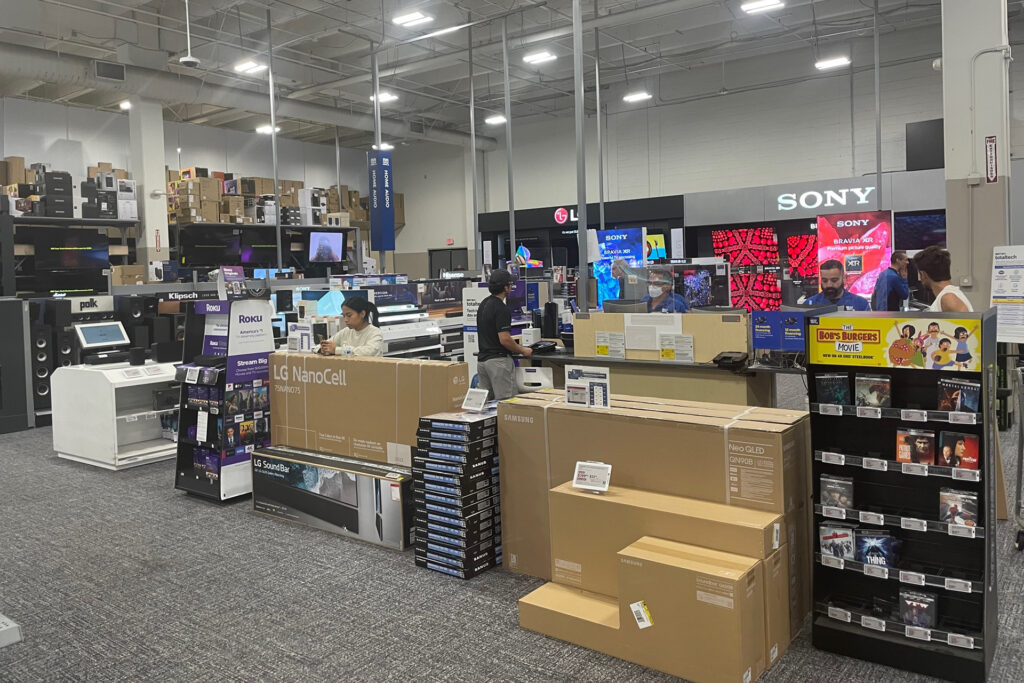Few things in this world bring the feeling of dread in the way that having to contact customer support can. But as a person who has spent close to 10 years of their career working in technical support (all the way from answering the phones to resolving the most complicated issues and managing large teams of support staff), there are things you, the consumer, can do that can help improve your experience and add some goodwill at the same time.

Five Tips for Getting Great Audiophile Customer Service
- Always try to be friendly as the customer. When you’re frustrated because something isn’t working, it can be hard to be nice (I know this firsthand). However, we need to remember the person on the other side of the phone/chat/email is trying to help you. Also, if there is an issue where your gear needs to be returned, that power is in their hands, so it could mean you get your new item faster, or even an upgrade, if you are kind. A few very deep breaths is a good start to any customer support call.
- Always follow the troubleshooting steps that you are asked to follow. Some of these steps can feel silly and at times condescending, but the engineer who wrote them isn’t the person you are talking to. They need you to go through each step to help figure out the problem you are experiencing. Just go with the flow a bit and you will get a better outcome in a shorter period of time.
- The best time to contact any customer support is often the middle of the day. This can be hard if you work a nine-to-five-style job, but that is the reason why it is the best time to call. This puts you in at around 2pm EST or 11am PST. The people you are talking to at this time aren’t as busy, and therefore stressed, so they will be better prepared to provide their best support to you.
- Don’t be afraid to ask for something you might want when getting support. If you are calling for support because your DAC, or amplifier, or anything else, isn’t working properly, you shouldn’t shy away from asking for something as compensation. Just make sure you do it politely and be realistic about what you’re asking for. The larger companies sometimes are willing to do a free or cheap upgrade for you to ensure your brand loyalty, but often you will have to ask.
- Calling back can help. Not every customer service person is created equally. They are human, too, and perhaps the last person they spoke to was a raging Karen and they are a bit rattled. For big companies, calling back can be a faster way to get the desired result.

Audiophile Dealer Support Versus Direct Sales Support
Everyone has their preference when it comes to shopping. There will always be those who love going into their local audio salon to check out the gear they have on hand, in hopes of getting a really positive experience from an experienced salesperson who has training on the equipment they sell. Others would rather do their shopping from their couch at home, as they don’t like dealing with salespeople, and they feel like they already know exactly what they want. Each side of the argument has its merits, but the difference you get in support between the different types of retail can be radically different.
When you buy from your chosen audiophile dealer, you get someone who, by design, is motivated to help you get your problems resolved effectively. For example, let’s say you purchase a shiny new audiophile DAC and you get home and you plug it in and find that it simply doesn’t work. When you call your dealer, they will want to get the issue resolved for you as soon as possible for fear of losing commissions or, God forbid, you as a client. That retailer made the sale and they have some level of investment in you enjoying the item, as they want you to come back and make future purchases. This also enhances your relationship with your dealer, as you are building trust with the dealer when they are there for you in your time of need. Additionally, if that DAC is faulty, they could give you a new one the same day, or let you pick out something different from inventory to keep you really happy with the purchasing process.
The type of service that you can get from your dealer is something that potentially can be matched by an online retailer. Now, if the gear is older and requires servicing, a good retailer can use their established relationship with the brand, and they will be the ones who will deal with the wait times to get someone on the phone, do the troubleshooting, and really take on all the hassle on your behalf.
When you buy direct from the retailer online or from an online retailer, if you receive a faulty piece of equipment, you are going to have to be the one who deals with the support team and all the annoyances that can go along with that process. Now, a strong brand often has fantastic customer support, as they will do close to anything to keep their customer rankings as close to five stars as possible. At the best retailers, the people you talk to tend to have specialized knowledge, and the best people who do this job truly care about getting your issue resolved and will want to do their best to ensure you have a great experience. The worst ones, and we’ve all sadly experienced this, seem more motivated to get you off the phone and “close their case” rather than actually solve your problem. Note: this type of customer service directive isn’t entirely their fault. Most helpdesks have a KPI (key performance indicator) that measures two things that typically lead to poor support. The first is first call resolution, which measures how many of the tickets are resolved in the first interaction you have. While on the surface, you (and likely the business manager as well) will believe that the person who took your ticket was knowledgeable and was able to resolve your issue quickly, humans have a fascinating way of knowing how to cheat these systems once they understand them. This can lead to cases where the person you are working with did everything they could to try to convince you that whatever issue you were having wasn’t the issue of the manufacturer, just to close the case. The second one that can lead to poor service for you is “time to resolution.” This is a benchmark that a company sets where they want to ensure that all problems are resolved in a certain period of time. This again makes sense, but can lead to issues for you. When you are dealing with a piece of gear that has been on the market for years, the time to resolution should be predictable, whatever issues there might be with the technology have probably occurred more than a few times by now, so a known resolution likely already exists. However, for the most modern gear, there can be a lot of variables.
Think about the newest integrated amplifiers that also include some form of streaming. These items are running computer software or firmware that is capable of being updated. Every time software is updated, you have the chance of introducing a defect (aka: a bug). So that creates a window where the problem must be figured out for the first time. This will lead to longer resolution times. Where this can affect you most negatively is that, for people who deal with software, a defect can exist for hours, days, months or even years before it is ever resolved, depending on the severity of the defect. Also, there is a good chance that once your issue is classified as a defect, you might never hear from a human again. You will get pointed to a public forum where the company posts when the issue has been resolved. Needless to say, if you’re outside of your return window, these types of issues can be catastrophic for you, your audio system, and your faith in that brand. We’d like to think that these outcomes are rare.

How to Talk to Someone in Support to Get the Result You Desire …
When I was in my early 20s, I used to work for a large international phone company, supporting the businesses which they had contracts with. They would have contracts with companies that would buy lines and phones for thousands of individuals. They would reach out to us when there was an issue with a batch of phones they had received, or they needed to add or subtract virtual phone lines (these were cell phones, not land lines). With that often came a lot of goodwill, should the person you are talking to be kind enough to you. You had the ability/discretion to reduce the price of the phone, upgrade the phone, get preferred phone numbers and many other things. Later in my career, I was doing software support, often helping professors and universities with issues they were having with a specific software platform. In those cases, I didn’t have the ability to reduce prices or getting get them upgrades, but what I did have the power over was ensuring that their business was able to run smoothly, as this software was a vital part of their business and day to day experience.
On the customer side, showing some kindness and understanding meant that they had an ally in the department who might put their issues ahead of other clients. That is the real advantage: when you are kind to the person on the phone, they are more likely to want to get your problem solved first. Now, I cannot stress enough to you that, no matter how hard you have tried to solve the problem yourself at home, the person on the other end of the phone is required to go through the whole list of questions. They need to be able to rule different factors either in or out, which means they are going to ask you to do them again. You can either play along, and just say, yes, I’m doing that, or you can feel free to humor them and go through the steps again, even if it means this is the fourth time that you are turning the device off and back on again. If you want the time to go by as fast as possible, make small talk. People who take phone calls in support sometimes talk to somewhere between 20 and 100 people in a day. When you can have even a passable conversation with the person, it can be to your benefit, as the time is going to go by faster for both of you. It is also building goodwill with the person who is trying to help you. You never know what benefits this person is empowered to provide to you. At Apple, for example, they are able to bump your call to one of the Senior Support Experts, and these ninjas rarely fail to solve issues for you. They will troubleshoot external products with you in ways that no other company will normally do. They can give you support on products that are well out of warranty. Making every person in your process an ally will get you a better outcome.
Kindness matters, and if you feel that the support person is being rude with you, you are certainly welcome to tell them how you feel about their attitude or the level of service you feel they are providing to you, just keep in mind this person almost always has some level of power over making decisions about helping you get your issue resolved. Sometimes just calling back to get a fresh start to a nagging problem, specifically with bigger companies, is a strong strategy. You want to keep the good vibes flowing between you and your customer support agent because, in the end, you have the most to gain from a positive outcome.

Chat Versus Phone Versus Email Support
Chat, phone and email support are the primary ways that people get support from online retailers. Each one has their benefit, and each option is a little bit different than the other.
Chat support is the newest form of support of the three. Chat support is typically being provided through a chatbot, that you either click into, or can be made to open on their own with some predefined text. There was a time this was common, and certainly there will still be companies that employ a team of people to handle these questions. With the onset of AI, you are most likely going to be dealing with a computer, not a person. It will go through all the resources it can to try to answer your questions and, if it cannot, it likely will then put you into the human queue. This process can be clunky, to be polite, but requires you to be understanding.
The advantage of chat support is that you can get the answer to your problem, should the problem be known, almost right away. The downside is that AI doesn’t get things right 100 percent of the time, and its ability to get you the right answer is also very dependent on your ability to ask the right question, often in a nearly perfect format.
If you should be chatting with a human on the other side, the experience can be more variable. Often, the people working the chat are not located in the country where you live. Most of these jobs, along with people on the phone, were moved offshore to save costs in the 1990s and 2000s. So, they also need to understand your question, and English may not even be their first language (one of my employers used people in both Mexico and Costa Rica to handle chat support), so don’t be surprised if their use of English can feel awkward at times. The good part of having a real person, though, is they can ask you probing questions to try to help get your issue resolved quickly, instead of you getting moved into email support, which often takes much longer.
Phone support can be better for more complex or difficult customer service issues. In these cases, you are always dealing with a person on the other side on a one-to-one basis. The best brands/companies will employ the people to support their products themselves. The value here is that they have direct access to the engineers who designed and built the product, which means that you can get even the most difficult of problems solved relatively quickly. These individuals are also working the ins and outs of the products all the time, which brings the biggest benefits to the consumer, as the person you talk to is a true expert. Lesser companies and brands might use outsourced and/or offshore services. Sometimes this means that you are going to be talking to a person in India, no matter the time of day, but one of my past employers took a different approach to it. We had people working in Canada and the U.S. from 7:00 AM to 9:00 PM EST, which meant that most of the time, you were speaking to someone who had a similar dialect of English to you, and from 9:00 PM to 7:00 AM, they had people working in Australia. Now, understanding the person in Australia isn’t always easier than the person in India (keeping in mind for many people in India, English is their first language as well), but it ensured that you were speaking to a person living in a First World, comparable country helping you resolve your issues. The time at which you call for support, even for companies that offer 24-hour support, is key to your overall customer service outcome.
Email support is often the slowest of the three forms of support, but it has its perks. I recently had an experience with reviewing a DAC from one of the Chi-Fi brands. The experience with the company was largely positive. They were able to help me get the issue resolved (the voltage setting wasn’t set properly, despite coming with a North American power cord – very confusing); the only problem was that getting that issue resolved took a week. If we were on chat or the phone, the issue might have have been resolved in a few minutes. Fortunately for me, this was a DAC that I could live without, but that was a week that I couldn’t work on the review, and if the support was poor, it could have also added negative bias, either conscious or unconscious, toward the product. Many consumers, especially when buying from retailers with a liberal return policy, will just pack the sucker up and ship it back as to avoid the grief, wasted time and frustration. In that case, everybody loses in a “pound wise, penny foolish” outcome. Email support is a nice option for smaller companies, but the resolution needs to move quickly, and email isn’t really that quick of a communication method these days.
Final Thoughts on Customer Service in the Audiophile World (and Beyond) …
Support will be a vital part of any retail business, whether that means you’re dealing with a person face to face or an AI through your computer. These experiences, positive or negative, will influence how you ultimately feel about the brand, which is going to in turn affect your future purchases, and what you tell others about the brand as well.
The best experiences are always going to be the ones where your problem get resolved quickly. We didn’t spend our hard-earned money on audiophile gear to have it sit on the shelf in an unusable state. I suspect the best path to ensure you get the best possible support is going to be buy from a respectable dealer whenever possible, and when that isn’t an option, try to buy directly from the brand itself, as they have very high motivation to give you topnotch support. Direct resellers will always be the most interested in getting your issue resolved quickly and, if the issue isn’t easily resolved, they may also be empowered to give you some goodies to try to ensure that you leave the experience thinking positively of their brand.
The advantages AV dealers have over online retailers will always be there and you should keep that keep that in mind when you make your next purchase. The reality is that not everybody lives in an area where there is a strong AV retailer. For many in North America, Best Buy or some big box store can be that. The Geek Squad can try to help. A Magnolia team member might also have some good insights, but that is generally not the same experience that you will get from a traditional audiophile salon. Then again, said audiophile salon won’t want to return things with the same ease. They won’t often have the on-hand inventory to replace a unit for you that day the way a big box store can do. There is a place for all these retailers, with pluses and minuses.
Understanding the inner workings of how customer service operates in the modern world will, I hope, give you some insights into this often maddening process of getting customer support. Coming to the party with a good attitude and an overall level of empathy for the person helping you is likely the best tip I can give you. In the end, the only thing that matters is that you get the result that you want. Getting to that desired result quickly and with the minimum level of aggravation should be any audiophile’s goal.
Do you have any audiophile customer service stories (good or bad) that you would like to share? We will approve your moderated comments quickly. We love to hear from you!




Great article and recommendations. One thing that should be noted however, is that many of the specialist companies in our business are quite small, and may only have one or two agents available for customer service. There may not be anybody available nights, holidays or weekends like at the big guys. So please don’t be impatient if it takes some time for a call back. It is often best to leave an email or message outlining the problem, that way the agent can research the answer before responding, saving time for both the agent and the customer.